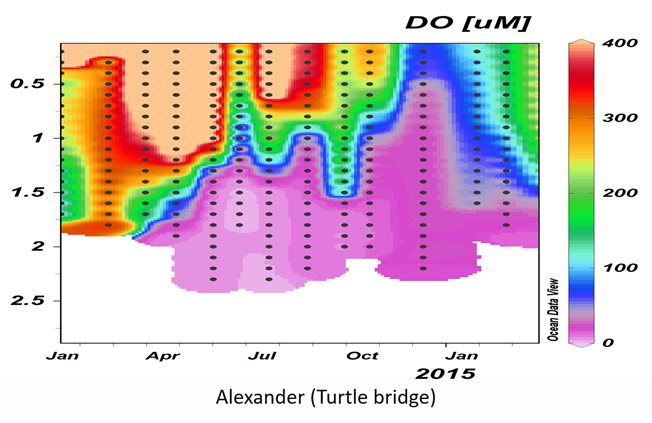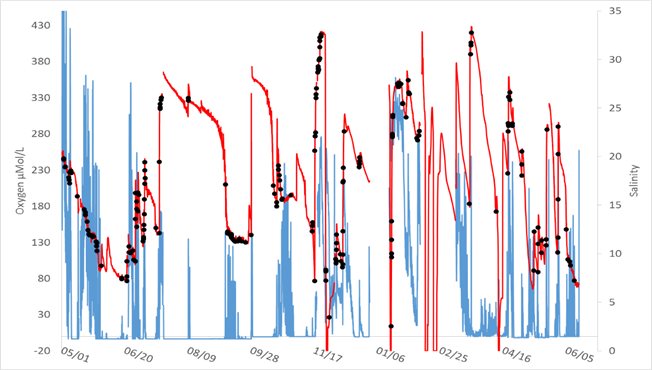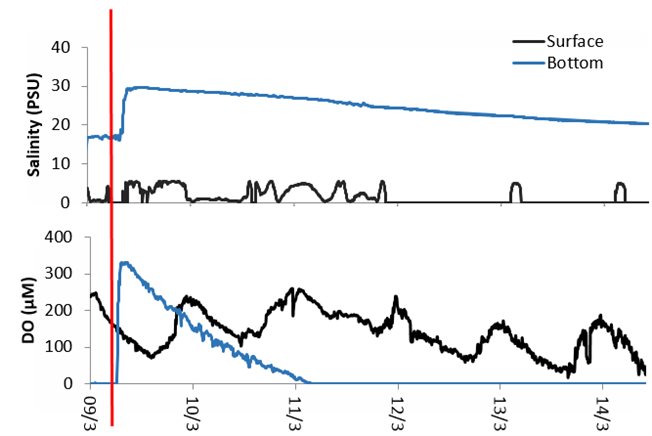An experiment we conducted show that sandbar breaching in order to enable seawater to enter the estuary increases nottom water oxygen concentration which supports more diverse ecosystem, but the increase is too short lived and the sandbar retains it original shapes within hours. the possibility of long term maintanence of the sandbar should be examined
introduction:
One of the aims of the Israeli estuarine research center is to identify the ecologic stress factors in the Israeli estuaries and to identify methods to reduce this stress.
By the end of the first year of reserch, we identified that the oxygen concentration at the Alexander estuary bottom water are low and reach close to nothing for prolonged periods, especially during summer and fall (figure 1 and 2). The environmental consequence is that oxygen breathing organisms such and fish, Arthropods and invertebrates are unlikly to survive in these conditions.

Figure 1: oxygen concentration at the Alexander estuary ~400 meters upstream from the outfall January 2014 to march 2015. The sampling time and depths are indicated by black dots.
What causes the oxygen stress and how does the sea affect the estuary
The Mediterranean estuaries are characterized by fresh water which are extremly inorganic nutrient reach due t high concentration of effluents. The seawater that enter the estuary downstream, in conjunction, are extremely nutrints poor. The rich fresh water encourages high primary productivity which in turn leads to high oxygen consumption by bacteria and to reduced oxygen concentration. Seawater that enter the estuary through the sandbar at the outflow to the sea “ventilates” the bottom water (figure 2). Seawater entrence is usually limited by the sanbar that is formed at the estuary outflow point to the sea.

Figure 2: sharp salinity and oxygen gradients during the events of seawater entering the estuary. salinity (red on righ Y axis) and oxygen (blue on left y axis) in the Alexander estuary 400 meters upstreams from the outfall. the black dots indicate simultaneous salinity gradient higher than 1 PSU/hour and oxygen gradient higher that 1µmol/L/hour.
Experimentally breaching the sanbar at the outflow to test the effect on bottom water concentrations
In a literature survey we conducted we found out the practices of sandbar breches is widly spread and decided to test the effect of such breaching on the Alexander estuary.
During the 36 hours esperiment (9-10/3/2015), we conducted a continouos measurement of the salinity and oxygen concentration at the lower part of the Alexander estuary. Ten hours after the beginning of the experiment, the sand bar was breached using a shovel tractor. The breach enabled oxygenated seawater to enter the estuary. The measurements that were conducted during the 26 hours after the breach recorded the breach effect.
Main findings
The sandbar breach caused an increase in bottom water salinity and oxygen concentration up to a distance of ~2Km upstream from the outfall. The effect is milder upstream. The high oxygen uptake rate and the fact that the sandbar was rebuilt within several hours after the breach (which stopes the water exchange between the sea and the estuary) caused a fast decline in oxygen concentration who reached anoxic levels two days after the breach.

איור 3: נתוני מדידות רציפות של המליחות (למעלה) וריכוזי החמצן (למטה) בגשר מכמורת לאחר פריצת השרטון (מסומנת בקו אדום אנכי). הנתונים נמדדו על ידי החיישנים הקבועים בעמודת המים.
Conclusions:
- occasional sandbar breach is not an adequate solution to the abottom water anoxia at the bottom water in ALexandrf estuary.
- To facilitate prolonged increase of oxygen concentration in the estuary a reduction in oxygen uptake rate must be achived. Such reduction can by achived by reducing the inorganic nutrients concentration.
- additional research should be performed to test the effect of prolonged sandbar openings on oxygen concentration, salinity, and ecologic community status.
The experiment was conducted with cooperation of the Israeli nature nature and parks authority
The researchers wish to thank the students Neder Maayan, Zur Meir, Zafriri Rony, and Reich Tom who conducted the experiment.


